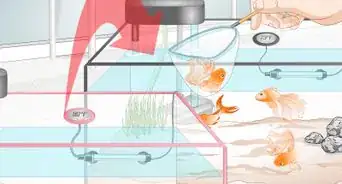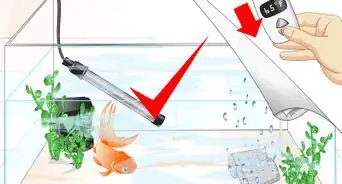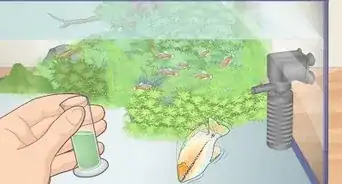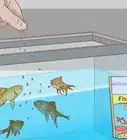This article was co-authored by Craig Morton. Craig Morton is the CEO of Aquarium Doctor Inc. based in Huntington Beach California and servicing Orange County, Los Angeles County, and the Inland Empire. With over 30 years of aquarium experience, Craig specializes in creating custom aquarium designs along with aquarium installation, service, and maintenance.
There are 12 references cited in this article, which can be found at the bottom of the page.
wikiHow marks an article as reader-approved once it receives enough positive feedback. In this case, 100% of readers who voted found the article helpful, earning it our reader-approved status.
This article has been viewed 187,568 times.
Fish are graceful, low-maintenance pets. They come in many varieties and colors that you can mix and match in an aquarium to create a striking addition to any home. However, they can be susceptible to stress and illnesses. Proper care, tank maintenance and your ability to diagnose symptoms will help keep your fish healthy and allow you to deal with any problems that may come up.
Steps
Caring For Your Fish
-
1Observe your fish. See how your fish swims, breathes, eats and interacts with other fish. Get an idea for what is normal so you know when something abnormal is going on. A healthy fish has a decent appetite and is an active swimmer in your tank.[1]
-
2Learn about your fish species. You will need to research specific requirements for the tank size, temperature, maintenance, equipment and food needed to keep the type of fish you have healthy. Salt water and fresh water fish have different requirements.
- Saltwater fish need more maintenance and are not as hardy as most freshwater fish. Their water composition must be checked regularly. You will need special equipment, such as a hydrometer to regularly measure the specific gravity of the water as well as quality salt mixes. [2]
Advertisement -
3Avoid stressing your fish. A low-stress environment is the best way to keep your fish healthy. When fish are stressed, their immune system is weakened so they are more susceptible to disease. Preventing stress through regular maintenance and care will go a long way to protect your fish from getting sick.
- Regularly maintain the tank through partial water changes. Change about a quarter of your tank's water every other week.[3]
- Feed your fish a nutritious, varied diet. Most fish can do fine and even thrive on processed flake, stick or pellet food. Adding some variety in their diet will help add some nutrition and fiber, such as frozen or freeze-dried bloodworms, live or frozen brine shrimp and some vegetables.
- Do not overfeed your fish.[4] Feed your fish only what they will eat in 3 minutes. Not only can excess food foul the water, but it can also make your fish sick.
- Check to make sure your filtration system is working effectively. Filters remove harmful toxins such as ammonia and nitrites from the water.
- Give your fish enough tank room to live comfortably. Don’t overcrowd them. A good rule-of-thumb to follow is no more than 1 inch (2.5 cm) of fish per gallon.
- Put only compatible fish species together. You don’t want your fish to eat, hurt or aggressively compete with each other. Peaceful fish will be stressed if kept with aggressive fish as well as fish species that communicate differently through body language.
-
4Maintain water temperature. Your tank’s temperature needs to match the needs of your fish. Keeping the tank too cold or warm will stress your fish. For example, goldfish prefer temps under 70 °F (21.1 °C), while most tropical fish need the water to be around 73–79 °F (23–26 °C). [5]
-
5Get your fish from a reputable store. Fish that have been living in an overpopulated, dirty tank will be under stress and could carry disease that might infect all your fish. Spend a little more for quality fish rather than fish that could die less than a month later.
- The store's fish tanks should be clean with active, brightly colored, unstressed fish.
- The store should offer return policies on fish and provide full credit on fish that die the first few days after purchase.
- Sales staff should be knowledgeable about fish as well as tank set up, sizes, inhabitants, diseases, ect.
- Generally, stores that specialize in aquariums and fish are best.
-
6Acclimate fish before adding them to your tank. Adding fish directly to your tank can stress fish and even kill them. The water in your tank and the store tank likely differ in temperature and water composition. The fish needs to gradually get used to its new environment.
- Keep store water out of your tank because it can carry diseases or parasites.
- If you can, quarantine new fish for 2 weeks before adding them to your tank. In this case, get the fish used to the quarantine bowl or tank’s water first—not the main tank. Watch for signs of disease and adjust the water or medicate, if needed.
- Set the fish bag in your tank. After 30 minutes add ¼ cup of tank water into the bag. Do this every 15 minutes for an hour. If the bag gets too full just remove extra water. Afterward, net the fish and place it in its new tank.[6]
- For the first few weeks, watch new fish carefully for signs of stress and disease.
Diagnosing Sick Fish
-
1Check for symptoms of stress. Your fish will not be acting like they normally do. They may seem distressed, have no appetite, hide, have nicked fins or sores.
- If your fish is near the surface gasping for breath, this means it’s probably not getting enough oxygen. This can happen due to poor water circulation, gill damage, or toxins in the water.
- Fish that are always in hiding indicate that either its companions are too aggressive or the tank doesn’t have enough cover such as plants or rocks for the fish to feel safe while swimming.
- Fish with nicked fins or wounds that don’t heal might be the target of aggression from other fish. Minor cuts should heal quickly. Stress may be suppressing the fish’s immune system so it can’t heal normally. Check to make sure you have followed good care and maintenance techniques and remove aggressive fish.
-
2Check for symptoms of disease. Fish can get diseases such as parasites, fungus or infections. If your fish is sick, then that fish has likely been stressed for some reason. On top of treating the disease, you will need to remove the stressors to ensure the fish gets better and no others get sick.
- Fish who are sick may not seem hungry or may spit out food.
- Sick fish may lay at the bottom of the tank for long periods of time and seem lethargic.
- Some sick fish may rub their body on tank décor to scratch themselves.
- Sick fish often acquire a dull color and turn pale or gray.
- The tails or fins of sick fish may be clumped, closed, stiff, or seem to be falling apart.
- Sick fish will have open sores, white patches, lumps or spots on their body.
- Some sick fish may have swollen or protruding eyes.
- Differences in scale appearance could indicate disease, such as if scales are raised.
- An abnormally swollen or hollow belly is another sign of a sick fish.
-
3Diagnose bacterial infections. Fish with bacterial infections can be very sick. The bacteria causing the infection can be either gram positive or gram negative but unless you consult a veterinarian you may not know which type of bacteria is the problem. Your fish may require antibiotic treatment.
- Tail Rot or Fin Rot—Fins or tails appear to be getting shorter or falling apart with reddish areas that may be infected.
- Dropsy—A fish with dropsy may have a bloated belly, raised scales and have a pine-cone appearance.
- Popeye (Exopthalmia)—The fish may have cloudy, protruding eyes or a bubble over the eye region. One or both eyes can be affected.
- Tuberculosis—Fish affected with tuberculosis may die suddenly. Symptoms can include open sores, body deformities, raised scales, fin and tail rot, and gray lesions. People can catch this deadly disease from handling infected fish. Do not handle sick fish and disinfect your hands after touching tank equipment.
- Septicemia (Red Streaks)—The fish may have bloody red streaks across its body or fins. They may also have clamped fins, bloating, ulcers, gasp for air and lethargy.
-
4Diagnose fungal infections. Like bacteria, fungus is naturally present in your tank. When fish are stressed or injured, the mucous layer they produce that protects them from infection becomes damaged. They are then susceptible to fungus.
- Cotton Wool Disease—There may be white, yellowish-brown, or whitish-gray growth on the body, fins or mouth. These growths may look like cotton tufts and can appear on the top of the fish as well. There could be redness around infected areas, along with lethargy, loss of appetite and body rubbing.
-
5Diagnose parasite infections. Fish with internal parasites may have a normal appetite but still appear to lose weight. They may also be lethargic.
- Ich (Ichthyophthirius)—This condition is caused by a parasite and will show up as white dots all over the fish’s body and head that look like salt. Fins may be clamped.
- Velvet—The fish may be lethargic, have clamped fins, poor appetite, loss of color, may dart about and rub its body against décor and substrate.
- Body Slime Infection—A fish with this condition will be covered in a white film that can be raised in some areas, cloudy eyes and clamped fins.
-
6Diagnose other illness. Some diseases are syndromes that can have multiple causes, such as viral, bacterial, fungal, parasitic or genetic. You may need to consult the advice of a specialist to figure out what is causing the disease.
- Swim Bladder Disease (SBD) or Bloat—Your fish may have trouble swimming, not be able to stay upright, or swim on his side.
- Puffy Gills—This condition causes inflamed, reddish gills and gasping for breath.[7]
Treating Your Fish
-
1Quarantine your fish. Putting your fish in a sick bowl or tank may help keep the disease from spreading. It will also make it easier to administer medications. Make sure to use tank water from the main tank to keep from stressing your fish further.
-
2Check that the main tank’s water quality, temperature and pH are acceptable. Check for toxin buildup. Look to see if any other fish are showing signs of stress or disease. Quarantine other sick fish and try to find out why your fish are stressed.
-
3Treat all illnesses as soon as possible. A fish specialist or veterinarian can help you decide on proper treatment for your fish and provide prescription medications. Though fish medications for most fish illnesses may be available at pet stores, many have not been evaluated or approved by CVM. For this reason, you may not be sure whether they contain the correct amount of drug or are safe and effective.
- Always read and follow medication directions. Don’t overdose your fish. Make sure your fish are not a species that is sensitive to the ingredients.
- Use antibiotics sparingly. Antibiotic resistance is a real problem around the world that occurs when bacteria mutate and are no longer affected by the antibiotic treatment. Always try other treatments first and do not medicate healthy fish.
- Consider euthanizing very sick fish. Sometimes treatments just do not work so be prepared this possibility.
-
4Treat bacterial infections. Often, cleaning the fish tank and keeping conditions optimum can help your fish recover from an infection. However, using a product such as API Melafix Antibacterial Fish Remedy, Maracyn, antibacterial fish food or another antibiotic may help.
- Dropsy can be treated by adding no more than 2.5 teaspoons of epsom salts to the tank per 10 gallons (37.9 L) of water. This will draw some of the excess water out of the fish's body. Feed your fish antibacterial fish food for 7-10 days. Maracyn Two added to the water can also help.
- Fin-rot needs to be cured quickly because it can spread to the body. Treat with warm, clean water, a few drops of garlic juice, and a product that replaces the slime coat, such as Stress Coat by API. You may need Maracyn or an antibiotic like tetracycline.[8]
- Popeye can be treated similarly to other bacterial infections with Maracyn or tetracycline and antibiotic fish food. [9]
- Septicemia- A combination of Maracyn, other antibiotics like Kanamycin Sulfate and antibiotic fish food is the best way to treat this.[10]
-
5Treat fungal infections. Treatment for fungal infections, such as cotton wool disease, includes salt baths using freshwater aquarium salt, an antifungal agent like phenoxyethanol or Rid Fungus. You can also try applying the anti-fungal and anti-bacterial agent, Gentian Violet. [11]
-
6Treat parasite infections. Many organisms can make your fish sick. Formalin-based medications and copper sulfate are the most common treatments for parasite infections. However, changing certain conditions in the tank can also get rid of them.
- Ich can be treated with medication that is formalin based, contains malachite green, methylene blue or copper sulfate. [12]
- Body slime infection can be treated with formalin-based medication, copper sulfate or potassium permanganate. These parasites are also sensitive to salt and temperature. Raising water temperatures to 86 °F (30 °C) and adding salt at a dose of 0.4 to 0.7 ounce per gallon for 7-14 days can cure slime disease.
- Velvet disease can be treated by dimming the lights of the aquarium. Since velvet is caused by a protozoan that needs chlorophyll for nutrients, a lack of light starves the organism of food.[13]
-
7Treat other conditions. You can try to treat the symptoms of syndromes with the treatments already mentioned. More frequent water changes and tank maintenance can often help clear up problems in a few days or weeks.
- If your fish looks bloated, it may be constipated. To treat this, get a frozen pea. Shell it, thaw it, and cut into tiny pieces. Feed a few of these to your fish, then feed it nothing for a few days. You can also try feeding live, frozen, or freeze-dried daphne for the same results.
Maintaining Your Tank
-
1Change part of the water regularly. Not changing the water regularly is the most common cause of illness in fish, so this is one of the most important things you can do to keep your fish healthy. Monitor the water quality and ammonia, nitrite and nitrate levels by using water testing kits from your store. This will tell you how often and how much you need to change.
- Never change all of your tank water at one time. This change in water chemistry will likely stress your fish. You should not change more than 1/3 of the water in any 24 hour period.
- Some aquariums can do ok with changing 1/4 of the water every two weeks. However, most pet fish owners will need to do it more often. Changing 25% of your tank's water every other week helps to dilute and remove nitrates as well as replace trace elements and important buffers used up by bacteria.[14]
- You will also need to remove wastes hiding in the nooks and crannies of your aquarium. To do this, vacuum the gravel when you change the water. The exception to this is saltwater aquariums that use live substrates at the bottom.
-
2Perform regular maintenance on your filter. If your filter is not removing ammonia properly because it is clogged, your fish will get stressed and eventually die. Cleaning the filter usually involves either rinsing them in used tank water or vacuuming them.
-
3Treat tap water. Tap water has chlorine or chloramine in it so it’s safe for us to drink. However, these chemicals are toxic to fish and damages their gills, causing stress and illness.
- You will need to add the chemical sodium thiosulfate, available at fish stores, to the water before adding tap water to your tank. This will neutralize chlorine in the tap water.
- Chloramine can be neutralized through the use of products such as Amquel. These chemicals take care of the ammonia and chlorine in the chloramine molecules.
- If you don’t want to use chemicals to remove chlorine, you can leave circulating water via a filter or air-stone in a bucket or tank for 24 hours.
-
4Keep the water pH stable. Your fish will get stressed from rapid pH changes in tank water. Aim for a pH between 6.5 and 7.5. This is ideal for most fish.
- Tank water tends to become acidic over time because of nitrates that build up. The pH can be raised or lowered using chemicals such as muriatic (hydrochloric) acid or phosphoric acid. Phosphoric acid can raise the phosphate level in your tank and cause algae growth.
- Always treat water for pH adjustments prior to adding it to the tank.
- You can also bubble CO2 (carbon dioxide) through the tank via CO2 injection systems. This will lower the pH without the need for chemicals.
-
5Add plants. Aquatic plants can help your aquarium establish its own natural eco-system, protect from early fish loss, release oxygen, keep algae at bay and purify your water. Plants can also make your tank look really cool! [15]
-
6Add algae eaters. Your fish will benefit from having algae eaters control potentially harmful algae in the tank. These include shrimps, snails, and algae-eating fish.[18]
Expert Q&A
Did you know you can get expert answers for this article?
Unlock expert answers by supporting wikiHow
-
QuestionHow do you acclimate fish from one tank to another?
 Craig MortonCraig Morton is the CEO of Aquarium Doctor Inc. based in Huntington Beach California and servicing Orange County, Los Angeles County, and the Inland Empire. With over 30 years of aquarium experience, Craig specializes in creating custom aquarium designs along with aquarium installation, service, and maintenance.
Craig MortonCraig Morton is the CEO of Aquarium Doctor Inc. based in Huntington Beach California and servicing Orange County, Los Angeles County, and the Inland Empire. With over 30 years of aquarium experience, Craig specializes in creating custom aquarium designs along with aquarium installation, service, and maintenance.
Aquarium Specialist, Aquarium Doctor Inc.
-
QuestionHow long can a fish tank go without a water change?
 Craig MortonCraig Morton is the CEO of Aquarium Doctor Inc. based in Huntington Beach California and servicing Orange County, Los Angeles County, and the Inland Empire. With over 30 years of aquarium experience, Craig specializes in creating custom aquarium designs along with aquarium installation, service, and maintenance.
Craig MortonCraig Morton is the CEO of Aquarium Doctor Inc. based in Huntington Beach California and servicing Orange County, Los Angeles County, and the Inland Empire. With over 30 years of aquarium experience, Craig specializes in creating custom aquarium designs along with aquarium installation, service, and maintenance.
Aquarium Specialist, Aquarium Doctor Inc.
-
QuestionWhat do I do if my fish has an infection?
 Craig MortonCraig Morton is the CEO of Aquarium Doctor Inc. based in Huntington Beach California and servicing Orange County, Los Angeles County, and the Inland Empire. With over 30 years of aquarium experience, Craig specializes in creating custom aquarium designs along with aquarium installation, service, and maintenance.
Craig MortonCraig Morton is the CEO of Aquarium Doctor Inc. based in Huntington Beach California and servicing Orange County, Los Angeles County, and the Inland Empire. With over 30 years of aquarium experience, Craig specializes in creating custom aquarium designs along with aquarium installation, service, and maintenance.
Aquarium Specialist, Aquarium Doctor Inc.
References
- ↑ Craig Morton. Aquarium Specialist, Aquarium Doctor Inc.. Expert Interview. 21 July 2020.
- ↑ http://www.aboutfishonline.com/articles/waterparam.html
- ↑ Craig Morton. Aquarium Specialist, Aquarium Doctor Inc.. Expert Interview. 21 July 2020.
- ↑ Craig Morton. Aquarium Specialist, Aquarium Doctor Inc.. Expert Interview. 21 July 2020.
- ↑ http://www.aboutfishonline.com/articles/waterparam.html
- ↑ Craig Morton. Aquarium Specialist, Aquarium Doctor Inc.. Expert Interview. 21 July 2020.
- ↑ http://www.aboutfishonline.com/articles/sick-betta-fish.html
- ↑ http://www.aboutfishonline.com/articles/finrot.html
- ↑ http://www.aboutfishonline.com/articles/popeye.html
- ↑ http://nippyfish.net/sick-betta/septicemia-infection/
- ↑ http://www.liveaquaria.com/PIC/article.cfm?aid=80
- ↑ http://www.aboutfishonline.com/articles/ich.html
- ↑ http://www.aboutfishonline.com/articles/marinevelvet.html
- ↑ Craig Morton. Aquarium Specialist, Aquarium Doctor Inc.. Expert Interview. 21 July 2020.
- ↑ http://www.aboutfishonline.com/articles/aquarium-plants-benefits.html
- ↑ http://www.aboutfishonline.com/articles/aquarium-plants-benefits.html
- ↑ http://www.aboutfishonline.com/articles/aquarium-plants-benefits.html
- ↑ http://www.aboutfishonline.com/articles/algae-eaters.html
- ↑ http://www.aboutfishonline.com/articles/finrot.html
About This Article
To tell if your fish is sick, pay attention to its behavior. Sick fish may spend more time hiding, going to the surface to gulp air, or hovering close to the bottom of the tank than usual. You might also notice your sick fish refusing to eat or spitting out its food. Look out for changes in a sick fish’s appearance, as well. For example, check for wounds that won’t heal, rough scales, dull or bulging eyes, a swollen body, torn or jagged fins, or whitish spots on your fish’s body and fins. Your fish’s color might also fade or take on a dull, greyish appearance. Some diseases will even affect your fish’s ability to swim properly. If you think your fish is sick, isolate it in a separate tank and talk to a fish specialist or exotic pet vet for advice. They can help you determine the best treatment. For tips on how to treat your fish's sickness, including when to quarantine them, keep reading!
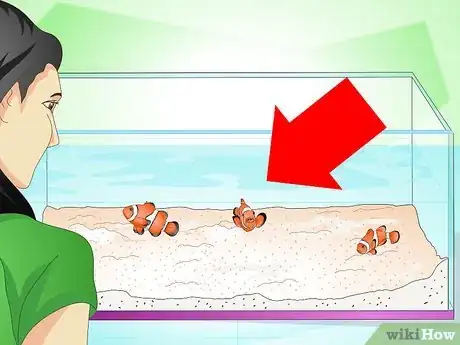

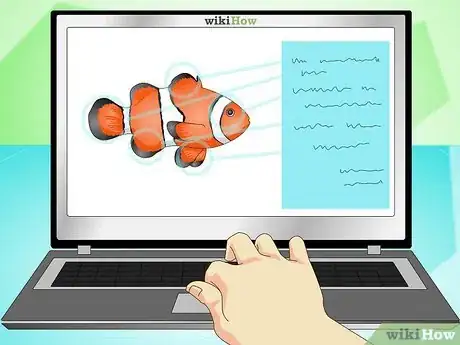

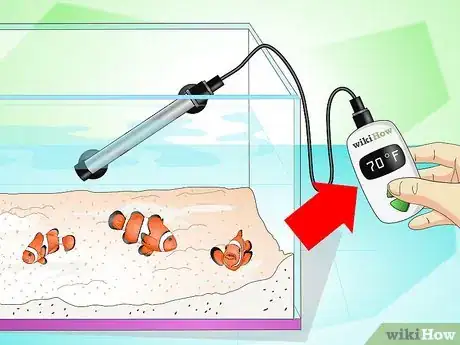

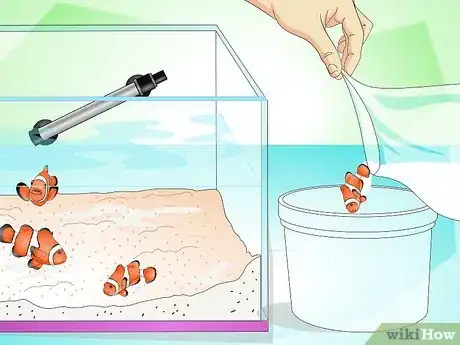
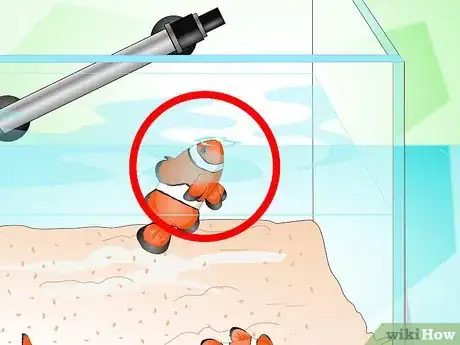

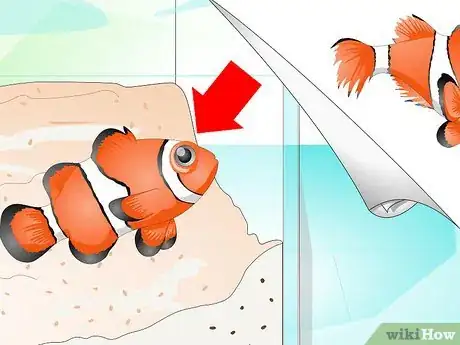
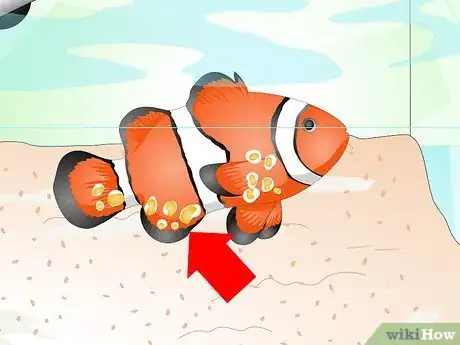
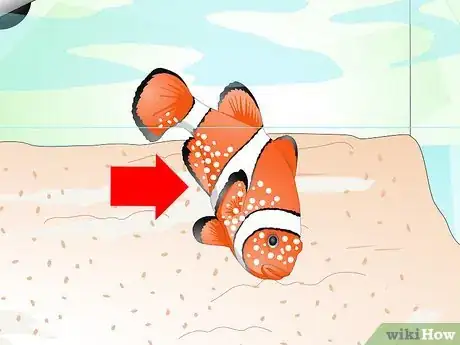
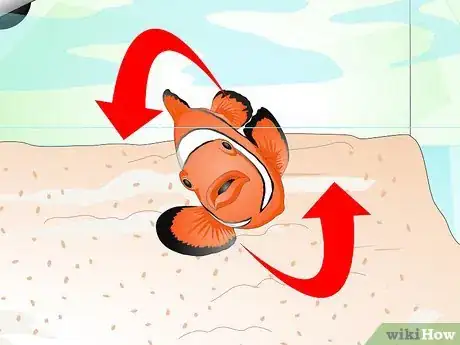
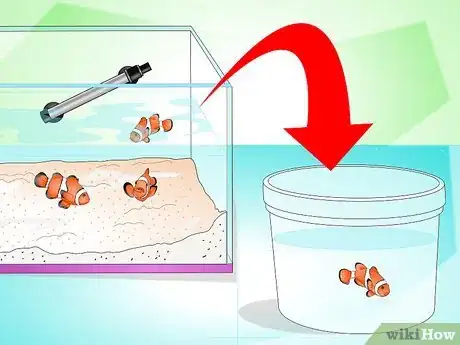

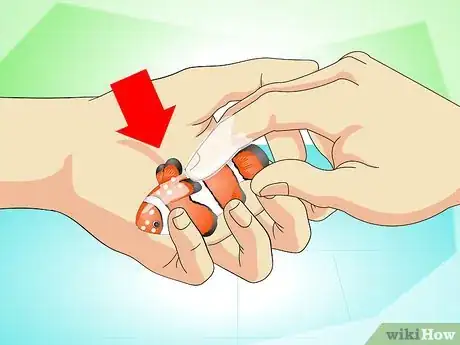
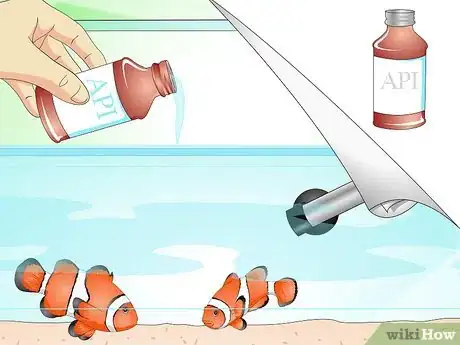
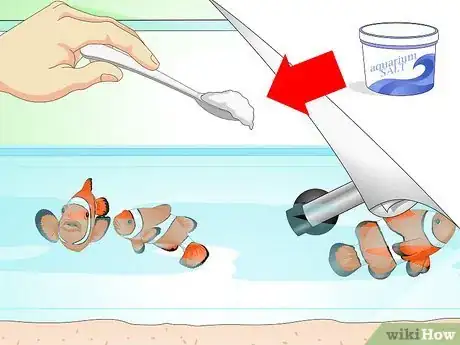
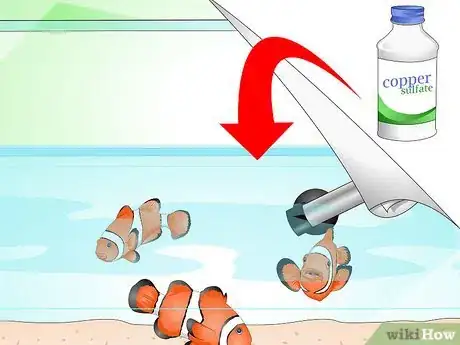
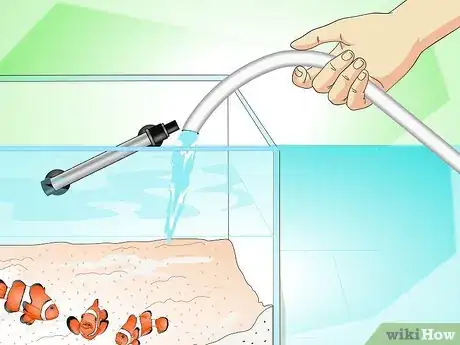
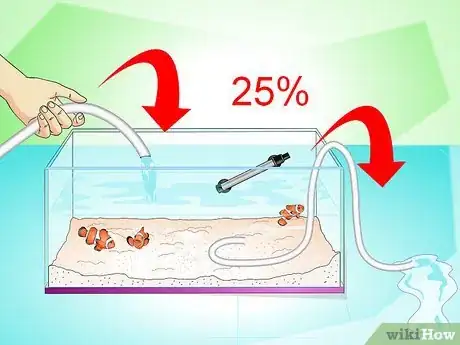


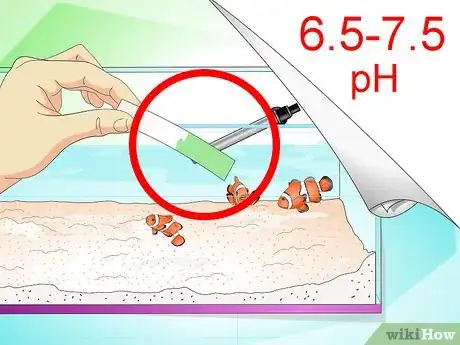
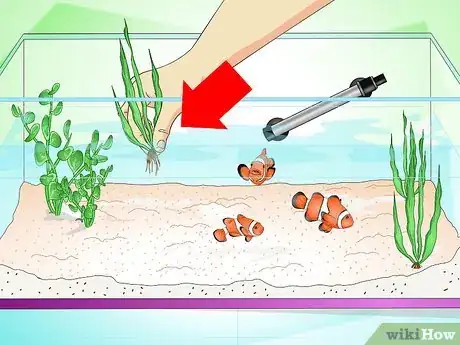
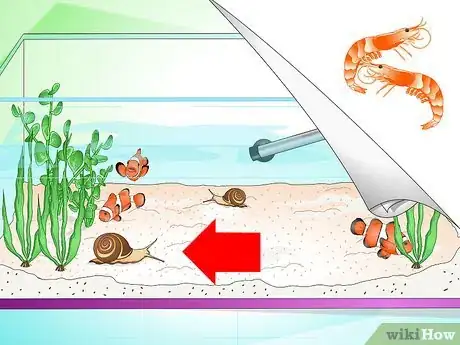




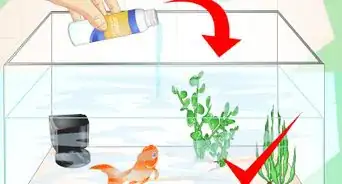
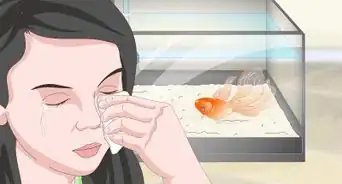

-Step-16.webp)

